SAAB 9-3 2008 Owners Manual
Manufacturer: SAAB, Model Year: 2008, Model line: 9-3, Model: SAAB 9-3 2008Pages: 320, PDF Size: 56.39 MB
Page 101 of 320
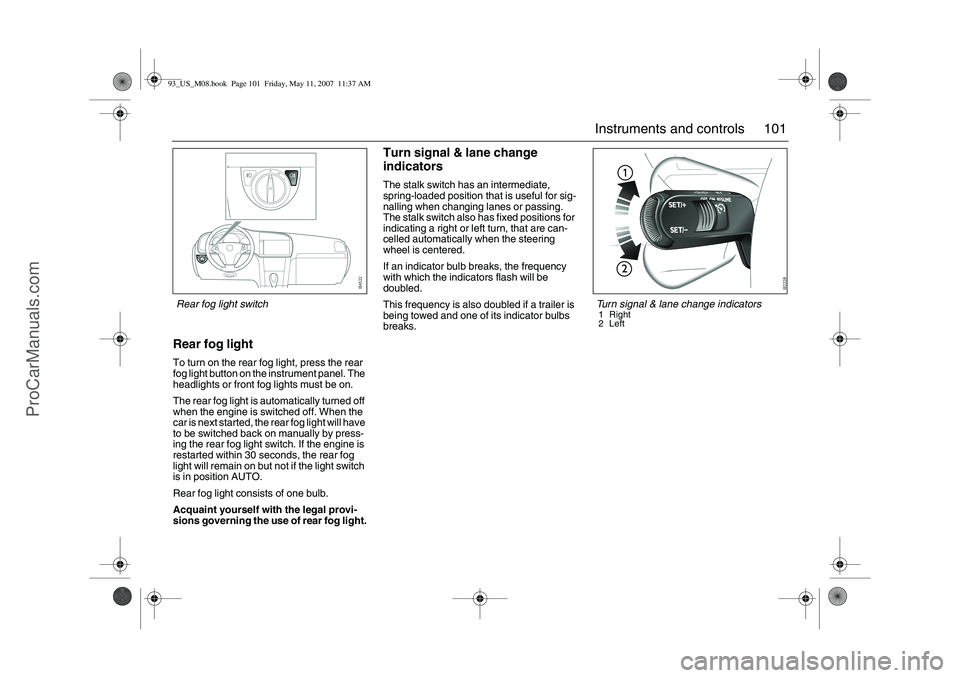
101 Instruments and controls
Rear fog lightTo turn on the rear fog light, press the rear
fog light button on the instrument panel. The
headlights or front fog lights must be on.
The rear fog light is automatically turned off
when the engine is switched off. When the
car is next started, the rear fog light will have
to be switched back on manually by press-
ing the rear fog light switch. If the engine is
restarted within 30 seconds, the rear fog
light will remain on but not if the light switch
is in position AUTO.
Rear fog light consists of one bulb.
Acquaint yourself with the legal provi-
sions governing the use of rear fog light.
Turn signal & lane change
indicatorsThe stalk switch has an intermediate,
spring-loaded position that is useful for sig-
nalling when changing lanes or passing.
The stalk switch also has fixed positions for
indicating a right or left turn, that are can-
celled automatically when the steering
wheel is centered.
If an indicator bulb breaks, the frequency
with which the indicators flash will be
doubled.
This frequency is also doubled if a trailer is
being towed and one of its indicator bulbs
breaks.
Turn signal & lane change indicators1 Right
2Left
Rear fog light switch93_US_M08.book Page 101 Friday, May 11, 2007 11:37 AM
ProCarManuals.com
Page 102 of 320
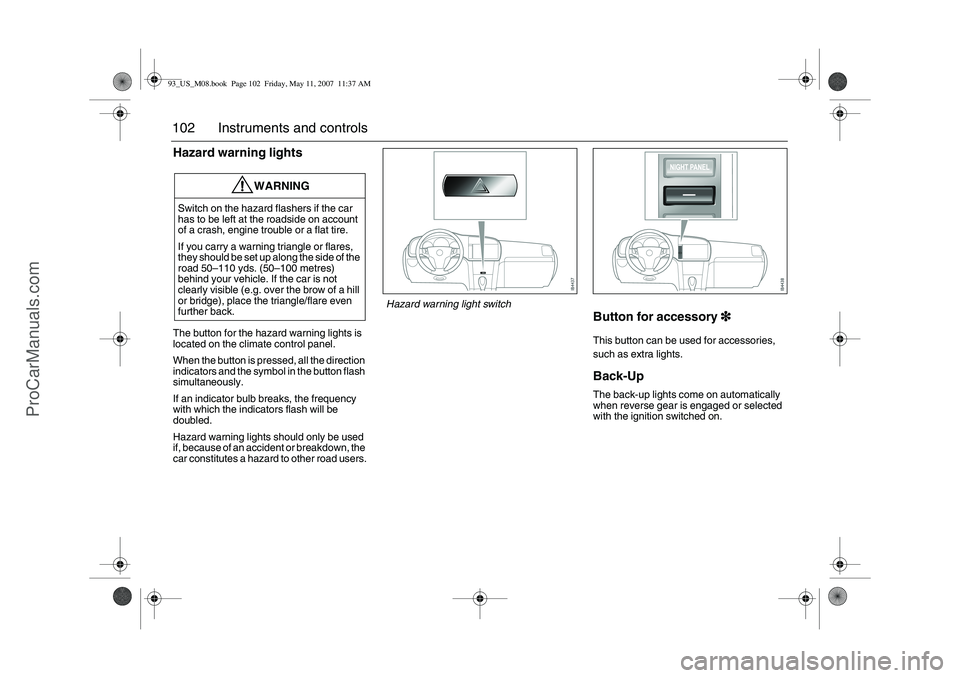
102 Instruments and controlsHazard warning lightsThe button for the hazard warning lights is
located on the climate control panel.
When the button is pressed, all the direction
indicators and the symbol in the button flash
simultaneously.
If an indicator bulb breaks, the frequency
with which the indicators flash will be
doubled.
Hazard warning lights should only be used
if, because of an accident or breakdown, the
car constitutes a hazard to other road users.
Button for accessory3
33 3This button can be used for accessories,
such as extra lights.Back-Up The back-up lights come on automatically
when reverse gear is engaged or selected
with the ignition switched on.
WARNING
Switch on the hazard flashers if the car
has to be left at the roadside on account
of a crash, engine trouble or a flat tire.
If you carry a warning triangle or flares,
they should be set up along the side of the
road 50–110 yds. (50–100 metres)
behind your vehicle. If the car is not
clearly visible (e.g. over the brow of a hill
or bridge), place the triangle/flare even
further back.
Hazard warning light switch
93_US_M08.book Page 102 Friday, May 11, 2007 11:37 AM
ProCarManuals.com
Page 103 of 320
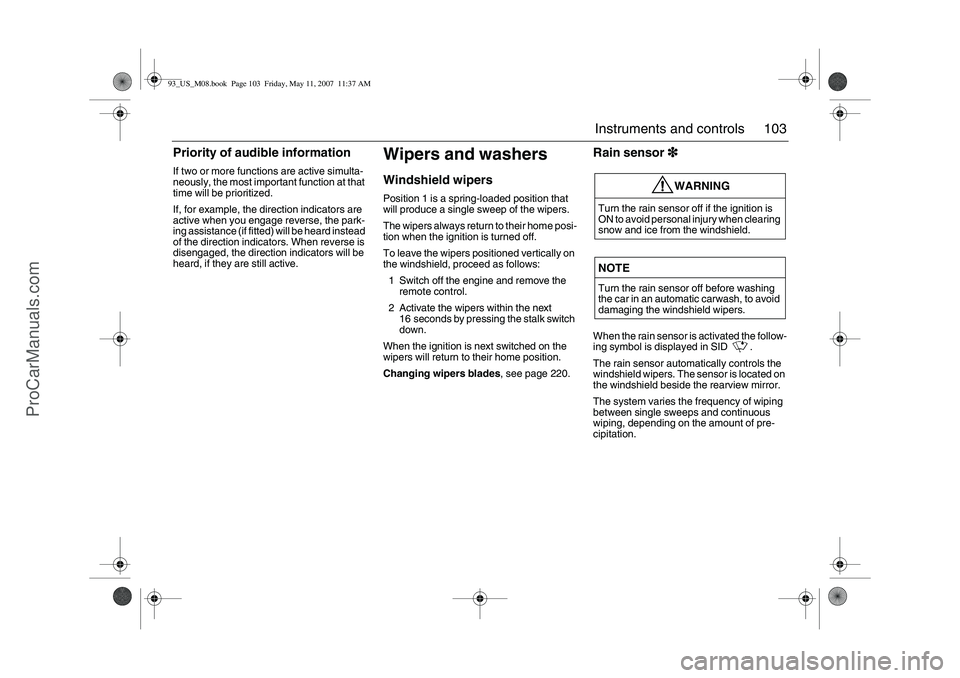
103 Instruments and controls
Priority of audible informationIf two or more functions are active simulta-
neously, the most important function at that
time will be prioritized.
If, for example, the direction indicators are
active when you engage reverse, the park-
ing assistance (if fitted) will be heard instead
of the direction indicators. When reverse is
disengaged, the direction indicators will be
heard, if they are still active.
Wipers and washersWindshield wipersPosition 1 is a spring-loaded position that
will produce a single sweep of the wipers.
The wipers always return to their home posi-
tion when the ignition is turned off.
To leave the wipers positioned vertically on
the windshield, proceed as follows:
1 Switch off the engine and remove the
remote control.
2 Activate the wipers within the next
16 seconds by pressing the stalk switch
down.
When the ignition is next switched on the
wipers will return to their home position.
Changing wipers blades, see page 220.
Rain sensor3
33 3When the rain sensor is activated the follow-
ing symbol is displayed in SID .
The rain sensor automatically controls the
windshield wipers. The sensor is located on
the windshield beside the rearview mirror.
The system varies the frequency of wiping
between single sweeps and continuous
wiping, depending on the amount of pre-
cipitation.
WARNING
Turn the rain sensor off if the ignition is
ON to avoid personal injury when clearing
snow and ice from the windshield.NOTETurn the rain sensor off before washing
the car in an automatic carwash, to avoid
damaging the windshield wipers.
93_US_M08.book Page 103 Friday, May 11, 2007 11:37 AM
ProCarManuals.com
Page 104 of 320
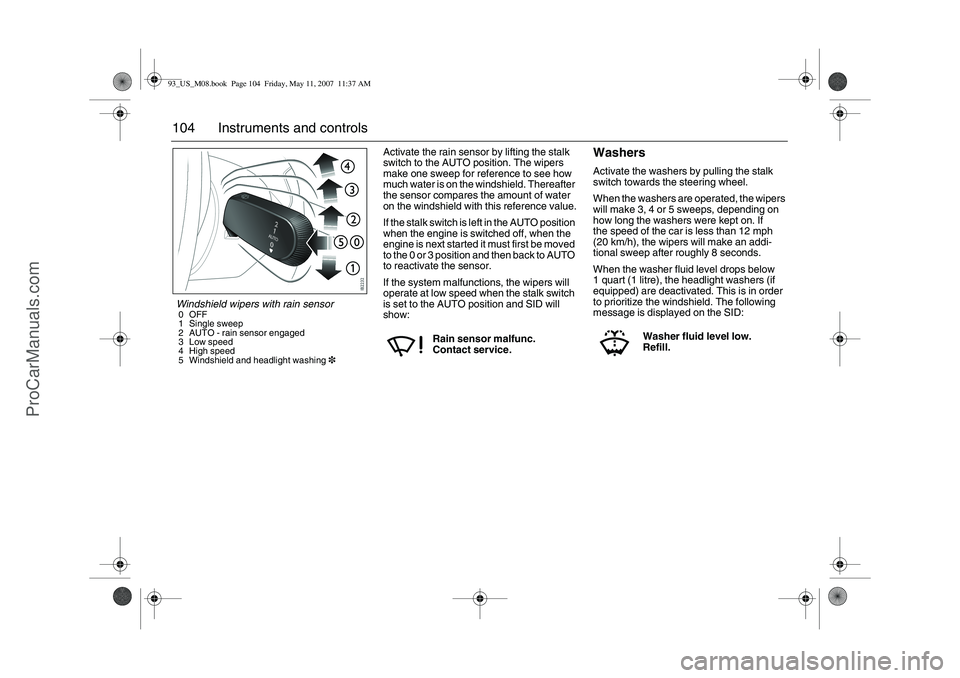
104 Instruments and controls
Activate the rain sensor by lifting the stalk
switch to the AUTO position. The wipers
make one sweep for reference to see how
much water is on the windshield. Thereafter
the sensor compares the amount of water
on the windshield with this reference value.
If the stalk switch is left in the AUTO position
when the engine is switched off, when the
engine is next started it must first be moved
to the 0 or 3 position and then back to AUTO
to reactivate the sensor.
If the system malfunctions, the wipers will
operate at low speed when the stalk switch
is set to the AUTO position and SID will
show:
WashersActivate the washers by pulling the stalk
switch towards the steering wheel.
When the washers are operated, the wipers
will make 3, 4 or 5 sweeps, depending on
how long the washers were kept on. If
the speed of the car is less than 12 mph
(20 km/h), the wipers will make an addi-
tional sweep after roughly 8 seconds.
When the washer fluid level drops below
1 quart (1 litre), the headlight washers (if
equipped) are deactivated. This is in order
to prioritize the windshield. The following
message is displayed on the SID:
Rain sensor malfunc.
Contact service.
Washer fluid level low.
Refill.
Windshield wipers with rain sensor0OFF
1 Single sweep
2 AUTO - rain sensor engaged
3 Low speed
4 High speed
5 Windshield and headlight washing393_US_M08.book Page 104 Friday, May 11, 2007 11:37 AM
ProCarManuals.com
Page 105 of 320
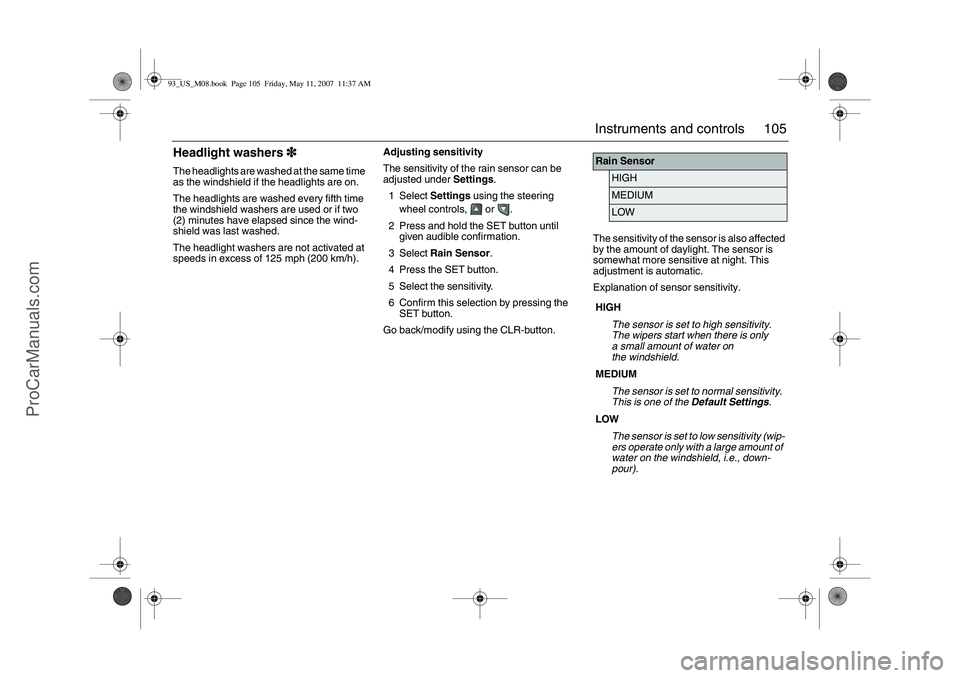
105 Instruments and controls
Headlight washers3
33 3The headlights are washed at the same time
as the windshield if the headlights are on.
The headlights are washed every fifth time
the windshield washers are used or if two
(2) minutes have elapsed since the wind-
shield was last washed.
The headlight washers are not activated at
speeds in excess of 125 mph (200 km/h).Adjusting sensitivity
The sensitivity of the rain sensor can be
adjusted under Settings.
1Select Settings using the steering
wheel controls, or .
2 Press and hold the SET button until
given audible confirmation.
3Select Rain Sensor.
4 Press the SET button.
5 Select the sensitivity.
6 Confirm this selection by pressing the
SET button.
Go back/modify using the CLR-button.The sensitivity of the sensor is also affected
by the amount of daylight. The sensor is
somewhat more sensitive at night. This
adjustment is automatic.
Explanation of sensor sensitivity.
Rain Sensor
HIGHMEDIUMLOW
HIGH
The sensor is set to high sensitivity.
The wipers start when there is only
a small amount of water on
the windshield.
MEDIUM
The sensor is set to normal sensitivity.
This is one of the Default Settings.
LOW
The sensor is set to low sensitivity (wip-
ers operate only with a large amount of
water on the windshield, i.e., down-
pour).
93_US_M08.book Page 105 Friday, May 11, 2007 11:37 AM
ProCarManuals.com
Page 106 of 320
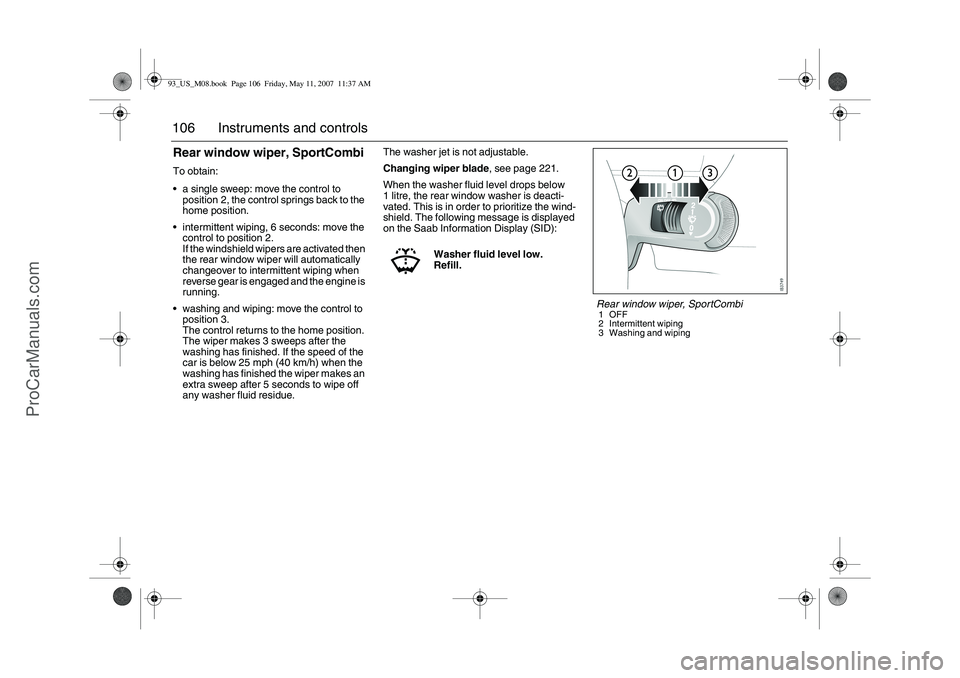
106 Instruments and controlsRear window wiper, SportCombiTo obtain:
a single sweep: move the control to
position 2, the control springs back to the
home position.
intermittent wiping, 6 seconds: move the
control to position 2.
If the windshield wipers are activated then
the rear window wiper will automatically
changeover to intermittent wiping when
reverse gear is engaged and the engine is
running.
washing and wiping: move the control to
position 3.
The control returns to the home position.
The wiper makes 3 sweeps after the
washing has finished. If the speed of the
car is below 25 mph (40 km/h) when the
washing has finished the wiper makes an
extra sweep after 5 seconds to wipe off
any washer fluid residue.The washer jet is not adjustable.
Changing wiper blade, see page 221.
When the washer fluid level drops below
1 litre, the rear window washer is deacti-
vated. This is in order to prioritize the wind-
shield. The following message is displayed
on the Saab Information Display (SID):
Washer fluid level low.
Refill.
Rear window wiper, SportCombi1OFF
2 Intermittent wiping
3 Washing and wiping
93_US_M08.book Page 106 Friday, May 11, 2007 11:37 AM
ProCarManuals.com
Page 107 of 320
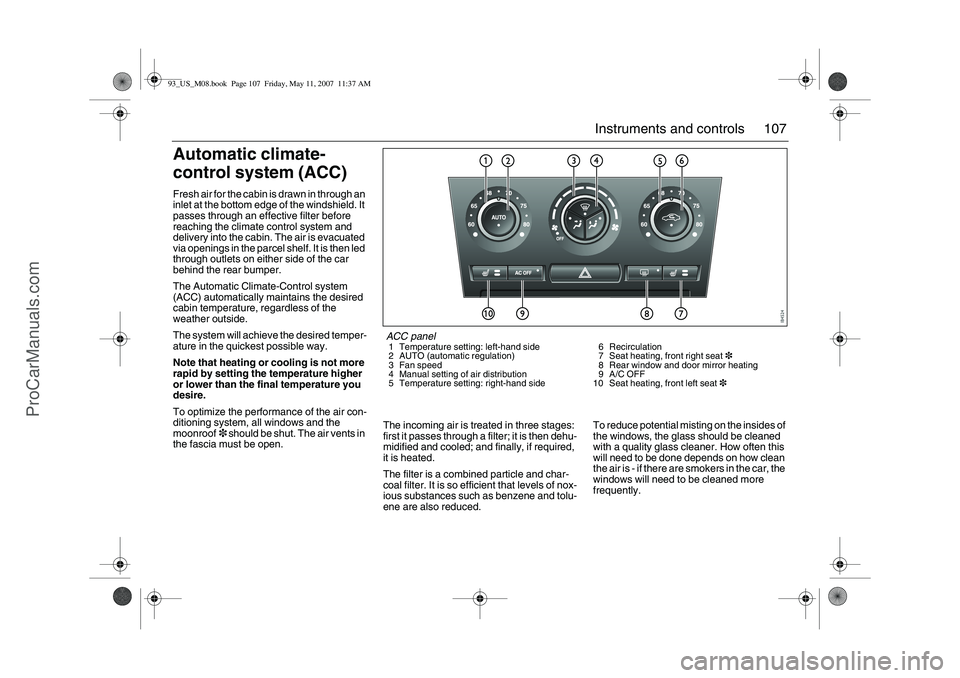
107 Instruments and controls
Automatic climate-
control system (ACC)Fresh air for the cabin is drawn in through an
inlet at the bottom edge of the windshield. It
passes through an effective filter before
reaching the climate control system and
delivery into the cabin. The air is evacuated
via openings in the parcel shelf. It is then led
through outlets on either side of the car
behind the rear bumper.
The Automatic Climate-Control system
(ACC) automatically maintains the desired
cabin temperature, regardless of the
weather outside.
The system will achieve the desired temper-
ature in the quickest possible way.
Note that heating or cooling is not more
rapid by setting the temperature higher
or lower than the final temperature you
desire.
To optimize the performance of the air con-
ditioning system, all windows and the
moonroof3 should be shut. The air vents in
the fascia must be open.The incoming air is treated in three stages:
first it passes through a filter; it is then dehu-
midified and cooled; and finally, if required,
it is heated.
The filter is a combined particle and char-
coal filter. It is so efficient that levels of nox-
ious substances such as benzene and tolu-
ene are also reduced.To reduce potential misting on the insides of
the windows, the glass should be cleaned
with a quality glass cleaner. How often this
will need to be done depends on how clean
the air is - if there are smokers in the car, the
windows will need to be cleaned more
frequently.
ACC panel1 Temperature setting: left-hand side
2 AUTO (automatic regulation)
3 Fan speed
4 Manual setting of air distribution
5 Temperature setting: right-hand side6 Recirculation
7 Seat heating, front right seat3
8 Rear window and door mirror heating
9A/C OFF
10 Seat heating, front left seat3
93_US_M08.book Page 107 Friday, May 11, 2007 11:37 AM
ProCarManuals.com
Page 108 of 320
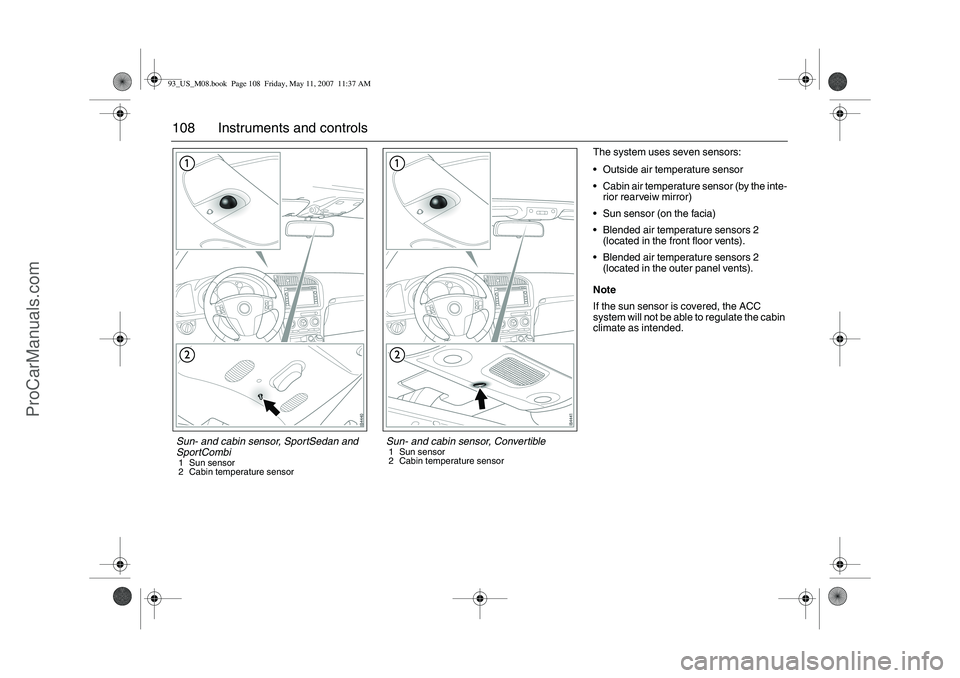
108 Instruments and controls
The system uses seven sensors:
Outside air temperature sensor
Cabin air temperature sensor (by the inte-
rior rearveiw mirror)
Sun sensor (on the facia)
Blended air temperature sensors 2
(located in the front floor vents).
Blended air temperature sensors 2
(located in the outer panel vents).
Note
If the sun sensor is covered, the ACC
system will not be able to regulate the cabin
climate as intended.
Sun- and cabin sensor, SportSedan and
SportCombi1 Sun sensor
2 Cabin temperature sensor
Sun- and cabin sensor, Convertible1 Sun sensor
2 Cabin temperature sensor
93_US_M08.book Page 108 Friday, May 11, 2007 11:37 AM
ProCarManuals.com
Page 109 of 320
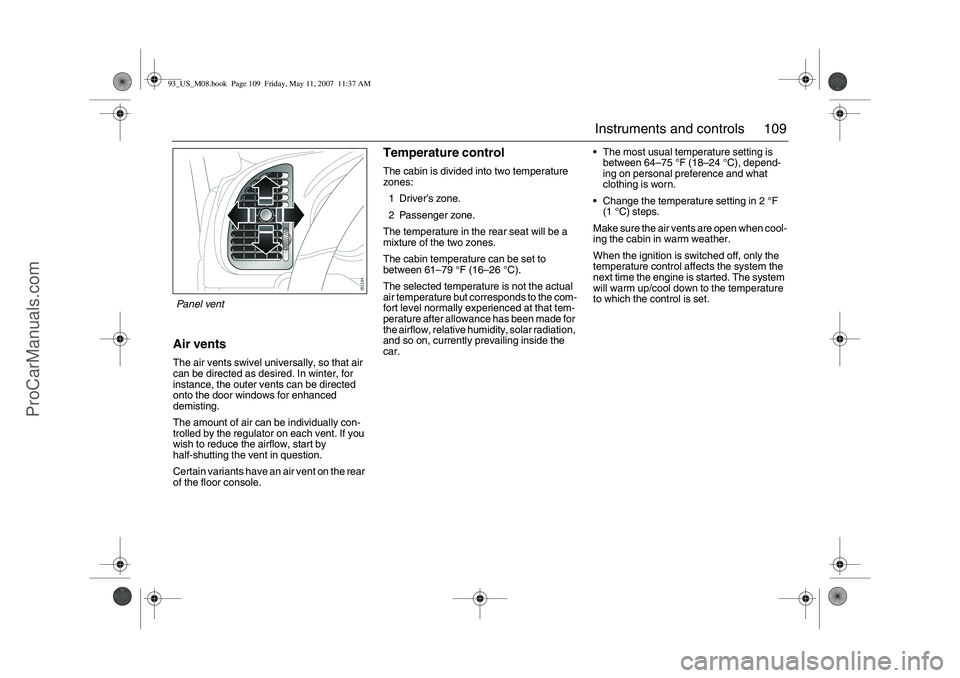
109 Instruments and controls
Air ventsThe air vents swivel universally, so that air
can be directed as desired. In winter, for
instance, the outer vents can be directed
onto the door windows for enhanced
demisting.
The amount of air can be individually con-
trolled by the regulator on each vent. If you
wish to reduce the airflow, start by
half-shutting the vent in question.
Certain variants have an air vent on the rear
of the floor console.
Temperature controlThe cabin is divided into two temperature
zones:
1Driver’s zone.
2 Passenger zone.
The temperature in the rear seat will be a
mixture of the two zones.
The cabin temperature can be set to
between 61–79°F (16–26°C).
The selected temperature is not the actual
air temperature but corresponds to the com-
fort level normally experienced at that tem-
perature after allowance has been made for
the airflow, relative humidity, solar radiation,
and so on, currently prevailing inside the
car.The most usual temperature setting is
between 64–75°F (18–24°C), depend-
ing on personal preference and what
clothing is worn.
Change the temperature setting in 2°F
(1°C) steps.
Make sure the air vents are open when cool-
ing the cabin in warm weather.
When the ignition is switched off, only the
temperature control affects the system the
next time the engine is started. The system
will warm up/cool down to the temperature
to which the control is set.
Panel vent93_US_M08.book Page 109 Friday, May 11, 2007 11:37 AM
ProCarManuals.com
Page 110 of 320
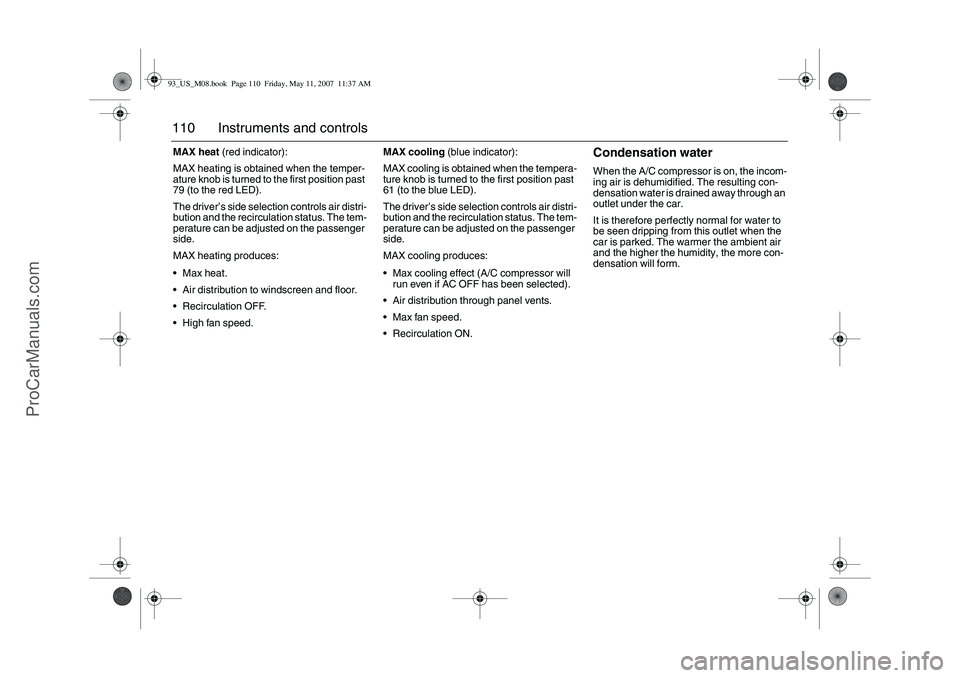
110 Instruments and controlsMAX heat (red indicator):
MAX heating is obtained when the temper-
ature knob is turned to the first position past
79 (to the red LED).
The driver’s side selection controls air distri-
bution and the recirculation status. The tem-
perature can be adjusted on the passenger
side.
MAX heating produces:
Max heat.
Air distribution to windscreen and floor.
Recirculation OFF.
High fan speed.MAX cooling (blue indicator):
MAX cooling is obtained when the tempera-
ture knob is turned to the first position past
61 (to the blue LED).
The driver’s side selection controls air distri-
bution and the recirculation status. The tem-
perature can be adjusted on the passenger
side.
MAX cooling produces:
Max cooling effect (A/C compressor will
run even if AC OFF has been selected).
Air distribution through panel vents.
Max fan speed.
Recirculation ON.
Condensation waterWhen the A/C compressor is on, the incom-
ing air is dehumidified. The resulting con-
densation water is drained away through an
outlet under the car.
It is therefore perfectly normal for water to
be seen dripping from this outlet when the
car is parked. The warmer the ambient air
and the higher the humidity, the more con-
densation will form.
93_US_M08.book Page 110 Friday, May 11, 2007 11:37 AM
ProCarManuals.com